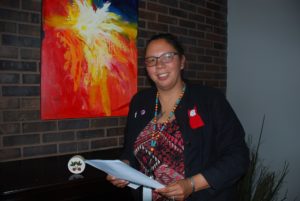Lisa Osawamick publishes story to explain girl’s fasting journey

By Laura E. Young
SUDBURY—As any writer knows, once the idea for a book lodges in the mind’s eye, the author–to-be can only submit to the creative process and write the book. All of which is why Lisa Osawamick, the Aboriginal Women Violence Prevention Coordinator at the Greater Sudbury Police Service, is set to publish Zaabidwin’s Fasting Journey, in English and Ojibwe in August.
“I think it’s going to be a really good read for children,” Osawamick says.
She will launch her book at the Wikwemikong Heritage Organization’s 2017 Annual Cultural Festival on August 5-7, in Wikwemikong Unceded Indian Reserve.
Osawamick received a grant from the Ontario’s Arts Council which she used to commission Nikki Manitowabi, an Anishinaabe artist from Wikwemikong.
It’s not as if Osawamick doesn’t have enough going on. She is setting up a conference in November for Sudbury police to address issues around violence prevention. She is part of the team bringing the Walking with Our Sisters Art Installation to Sudbury in January 2018.
The single mother of five, Osawamick completed her Master’s degree in social work, Aboriginal branch, at Laurier University in 2016. During the field work, she was on a four-day fast where she had a vision that she needed to write a children’s book. A story to explain fasting emerged. She wrote the story and submitted it as part of her final project.
But the story wasn’t over. Her younger children encouraged her to create a “real book,” Osawamick recalls.
The book will be printed in Ojibwe and English. Her mother, Martina Osawamick, an Elder at Cambrian College, will translate the text.
Osawamick’s daughter Hope, 12, thought she could use it to explain to her non-Indigenous friends what it means to go on a fast.
“I think it’s going to be a really good read for children,” adds Lisa Osawamick.
Osawamick comes to the publication of her first book as a survivor. A member of the Loon Clan and originally from Wikwemikong, Osawamick is a band member of Neyaashiinigmiing. She has resided in Sudbury since 1982.
Osawamick considers herself a survivor after her own struggles with depression, substance abuse and troubled relationships.
“I feel accomplished!” states Osawamick. “I hope that other women can feel the energy that I put out and for them to keep going and never give up. If I can do it – so can they!”
The key is to stay connected or connect with spiritual well-being; submersing in ceremonies always pulled her through, she says.
As well, she has always been drawn to helping others. She once wanted to be a crossing guard and was embarrassed about that until she completed her Master’s degree in social work.
“I ended up being that crossing guard in helping people safely cross the busy, chaotic streets out there!” notes Osawamick.
She loves the term role model because it shows the positive from the negative way of living.
“If I did not have my mother role modelling to me in how to be a good mother, I would not know myself how to be a good mother,” notes Osawamick. “She is one of my top role models!”
She also credits her mother with helping bridge the gap when the family moved from Toronto when Osawamick was six. They joined friendship centres in Toronto and later in Sudbury, following the programs that promoted culture, identity, language and pride.
“I carried all these life teachings into adulthood where today I am a strong Anishinaabe [Indigenous] Kwe [woman],” she says.
She remains happy to live in Sudbury, working to bridge gaps and barriers.
“We are open-minded and we work hard to have a safe and healthy community! Let’s continue to work together for a Sudbury everyone can say they are proud to call home!
Editor’s Note: What’s in a role model? Who is a role model? Is it a cliché, even a patronizing one or do so-called role model stories become necessary to balance the tide of negative stories? In this ongoing series, Ontario’s Indigenous women reflect on that term role model when they have a moment between their work serving in education, health, justice, and social work.


